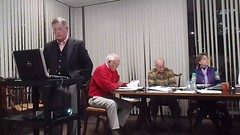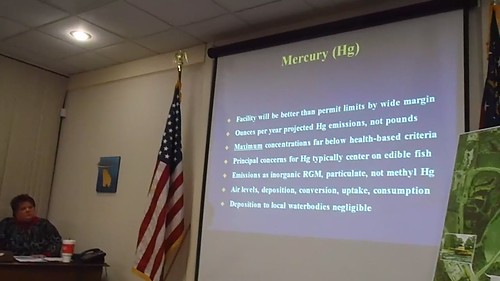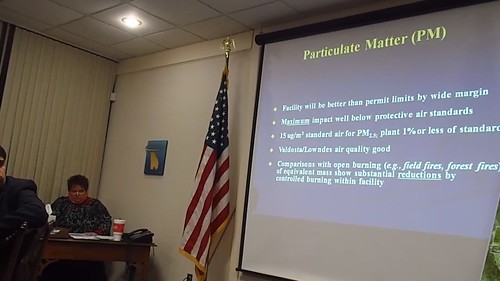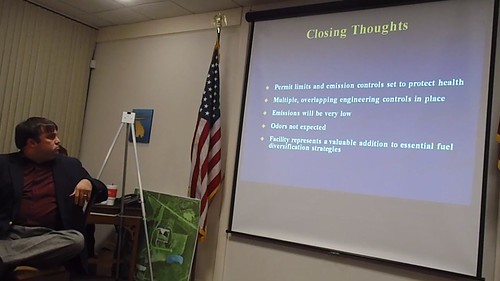 A week after Brad Lofton failed to produce evidence and offered
to file Dr. Noll’s correspondence “in the appropriate file”,
VLCIA has still not published the videos or slides from their
6 Dec 2010 event at the Rainwater Conference Center.
A week after Brad Lofton failed to produce evidence and offered
to file Dr. Noll’s correspondence “in the appropriate file”,
VLCIA has still not published the videos or slides from their
6 Dec 2010 event at the Rainwater Conference Center.
However, Brad Lofton and Col. Ricketts summarized that event for the VLCIA board at their recent board meeting, and they never presented any actual evidence there, either.
Brad Lofton said his toxicologist says the biomass plant in “no way shape or form” will cause health problems. Then he rattled off a long list of supporters of a Gainesville biomass plant. The rest of this post has videos of what he and Col. Ricketts said, plus screenshots of each of Dr. Teaf’s slides: see if you can find the details.
Lofton enumerated the speakers at the 6 Dec 2010 event. Can someone try to transcribe that list? None was given out at the 6 Dec event, and if it’s on the VLCIA web site, I can’t find it.
 Then
Col. Ricketts used what were apparently Dr. Christopher M. Teaf’s
slides from the Rainwater event.
Then
Col. Ricketts used what were apparently Dr. Christopher M. Teaf’s
slides from the Rainwater event.
The slide on “Basic Issues” gives the flavor right off:
What people had an image of a biomass facility as a “smoky fire pit”? It’s VLCIA and Wiregrass LLC that keep talking about visible emissions; what everybody else is talking about is health effects, particulates, and odor.
Bullet number two tells us how to think:
Facility must be judged on engineering, emissionsAs a pine tree farmer, I’m also interested in fuel sources and forest health, thank you very much. Like many other people, I’m also interested in human health. Not to mention economic risks and the cost in credibility of the VLCIA.
Next slide: Fuel Availability. Hm, unless fuel is emissions, Dr. Teaf contradicts himself already, or we aren’t supposed to use this slide to judge. I’m still waiting for the redacted fuel study from Sterling. If I don’t get it soon, I will go ahead and post a critique of what was presented at Rainwater about that.
Meanwhile, VLCIA board chair Jerry Jennett just discovered through some other source that there’s a wood pellet plant going in in Waycross, so it’s a little hard to believe this fuel sourcing study was very thorough. Neither Lofton nor Ricketts mentioned that Waycross plant as being taken into account in the fuel sourcing study.
Regarding emissions controls, Col. Ricketts says “I won’t go into all that detail” and claims the details are in the air quality permit. That’s pretty much his (and Dr. Teaf’s) approach throughout: present no details, and cite no publicly available studies or scientific literature. Dr. Teaf’s slide on Mercury mentions unspecified criteria.
Dr. Teaf’s slide on Particulate Matter (PM) refers to unspecified standards,
and makes the dubious and unsupported claim “Valdosta/Lowndes air quality good”. It mentions “open burning (e.g., field fires, forest fires) (his italics), while saying nothing about prescribed burning, such as is necessary to maintain health of pine forests.
Its claim that burning in an incinerator wood “of equivalent mass show substantial reductions by controlled burning within facility” (his underlining) is misleading at best, since during thinning most tops and limbs are not burnt up, they are left to rot and become nutrients. Prescribed burns are also not all concentrated in a single point source of emissions.
Col. Ricketts took a break due to arrival of half a dozen new audience members, and then continued summarizing Dr. Teaf’s summary. Dr. Teaf’s slide on Dioxins repeats the highly dubious point about field burning that doesn’t even mention prescribed burns.
Col. Ricketts mentioned EPA and CDC about “where we are moving, the direction we are moving” apparently saying that since dioxins have been reduced in recent years it’s OK for us to emit them. I know some Agent Orange sufferers who would not agree.
On to Polycyclic Aromatic Hydrocarbons (PAHs).
The slide refers to scientific data with no citations. Where is this data? Citations, or it doesn’t exist! Col. Ricketts refers to “breathing roadside air” as being more dangerous, with no mention of the delivery trucks coming into the facility.
Finally, Col. Ricketts presents a slide from Dr. Teaf on Closing Thoughts.
Col. Ricketts touts the incinerator’s multiple overlapping controls. Sure, and so did the Harrisburg incinerator that’s been shut down twice and is now bankrupting Harrisburg, Pennsylvania.
Then Col. Ricketts claims VLCIA has
“made this presentation available to anyone in the community who asks for it”.Well, I keep asking for it to be put on the VLCIA web site so anybody who wants to can see it. Does “made available” mean you can come to a board meeting with a video camera and upload it to YouTube yourself, as LAKE did? Why is it that a professional entity funded by 1 mil of dedicated taxes can’t seem to manage that, while a tiny volunteer group can? What does that say about VLCIA’s ability to manage money?
Earlier in the presentation, Col. Ricketts repeatedly says “we” referring to VLCIA and Wiregrass Power, LLC: “we” approached Dr. Teaf, “we” commissioned studies, etc. OK, so tax money at least partly funded these studies. Let’s see them! Not just overview slides, either: the actual studies, with the actual data.
-jsq
PS: The rest of what Col. Ricketts and Brad Lofton said about biomass at the VLCIA board meeting will follow in another post.
PPS: To anyone who thinks it’s unfair for me to present these slides and videos with my commentary, remember I’ve been asking for quite a while now (for example I asked Brad Lofton in person after the event on 6 Dec 2010, and I asked Col. Ricketts on 23 Dec 2010) for the VLCIA to publish their own version themselves. I’m still asking for that.
Short Link:






… and if your try to get a video of the December 6 event, you will also be disappointed … we tried to get it from the VLCIA today … and were told that it was not available yet …
At the Jan. 13 forum, Joy Ezell described Dr. Teaf as a person who “never met a toxic chemical he didn’t like” and someone who has at least a sideline of being a professional expert witness (always for the industry).
I spent about ten minutes on the internet researching Dr. Christopher Teaf’s numerous paid endorsements around the country for various chemicals. This article
http://findarticles.com/p/articles/mi_m0VCW/is_8_27/ai_73959431/
was compelling. Dr. Teaf is on public record endorsing the safety of arsenic in wood as posing no health threats to children (or adults). Numerous lawsuits around the country were adjudicated against his “expert findings” and subsequently the EPA banned CCA (arsenic) treated wood in playground equipment because of the health hazards to children.
I only spent about ten minutes, but I uncovered much information re: how Dr. Teaf’s “expert” opinion has been trounced by some of the same governing agencies like the EPA that Mr. Lofton deems credible on other subjects. I found news coverage by WCTV over Dr. Teaf’s endorsement of the Tallahassee biomass incinerator, I’ve read a letter from several of his colleagues in his own department at FSU opposing his opinion, and I found the letter written by the Tallahassee doctors’ association opposing Dr. Teaf’s opinion as to the safety of biomass incineration. I also found where the Tallahassee Democrat reported his endorsement of biomass and yet he did not disclose to them that he was paid by the industry to render his opinion, IOW, a paid consultant, for BG&E, which subsequently left Tallhassee when corruption probes were launched.
Other groups that oppose Dr. Teaf’s credibility as an expert witness include the ones WACE has already shared with the community: American Cancer Society, American Lung Association, and American Heart Association, etc.
I don’t understand why Dr. Teaf’s opinion is deemed more credible by Mr. Lofton and VLCIA board members than all the groups I just listed.